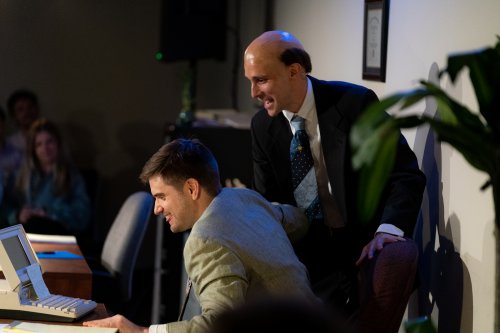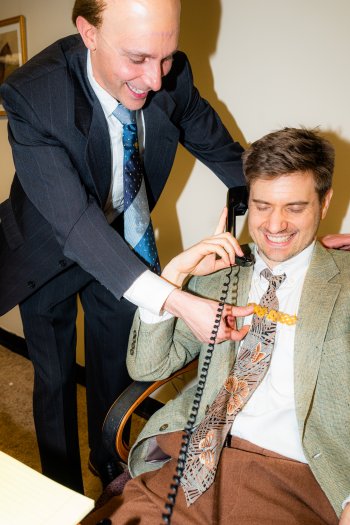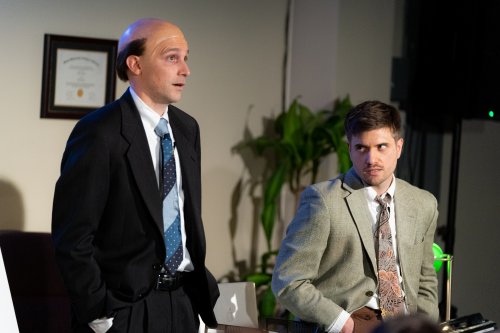Cellino v. Barnes: The Play
Twenty years of the business and personal relationship of lawyers Ross Cellino and Steven Barnes, depicted in three episodes.

Mike Breen and David Rafailedes in a scene from their “Cellino V. Barnes: The Play” at ChaShaMa at 320 West 23rd Street, in Manhattan (Photo credit: Spencer Pazer)
[avatar user=”Scotty Bennett” size=”96″ align=”left”] Scotty Bennett, Critic[/avatar]
Where does one begin to tell the story of two manifestly successful lawyers who mixed professionalism with adolescent ideation? A case where one wants a career as a serious law practitioner and the other not so much. But they both want to make money, and they both have egos that want to be in the spotlight.
I suspect that Mike Breen and David Rafailedes, the writers, performers and directors of Cellino v. Barnes: The Play, asked themselves the same question in 2017 when they decided to write a humorous play about the creation and impending demise of the Cellino & Barnes personal injury law firm. Unfortunately, in their effort to find the broad humor in the partnership’s creation and end, Breen and Rafailedes missed the mark.
For those of you who don’t know, Cellino & Barnes was a law partnership that became one of the major personal injury law firms in the United States until its dissolution in 2020. It was built up based on a jingle that became memorable and annoying at the same time.
Breen as Ross Cellino is believable as someone more interested in a “break the rules” approach to the practice of law than taking any of it seriously, with the exception of making a lot of money. Rafailedes puts on the character of Steven Barnes with an apparent “by the books” approach to a law practice but with a view that it may be all right to color outside the lines if it is done with care. He is also interested in making a lot of money. On the surface, it appears to be a perfect match, but it is not always what it seems initially.
The show explores twenty years of the business and personal relationship of Cellino and Barnes depicted in three episodes. The first starts with Barnes and Cellino meeting for the first time in Cellino’s office. The result is Barnes being hired as a junior associate by Cellino & Likoudis, a prominent Buffalo, New York, law firm which Ross Cellino’s father owns.

David Rafailedes and Mike Breen in a scene from their “Cellino V. Barnes: The Play” at ChaShaMa at 320 West 23rd Street, in Manhattan (Photo credit: Spencer Pazer)
After some humorous interactions regarding one of the firm’s clients and the reaction of the senior partners, Cellino and Barnes decide to start their own law firm. In arriving at this decision, they accidentally create an iconic jingle; “Cellino and Barnes, injury attorneys, call 800-888-8888, Don’t wait, call 8.”
Ten successful years later, it becomes apparent that Barnes is the serious lawyer, and Cellino is still not serious about it. After Barnes listens to Cellino’s wild interior design idea for the lobby of their building, Barnes adds his own wild idea to the mix. The difference in perspective between these two men, evident in their first encounter, has now become an ongoing issue in their business relationship.
In the final scene, twenty years later, the clash of egos, suggested at the beginning of their business relationship, has become a full-blown feud. The trigger is Barnes’ refusal to hire Cellino’s daughter. The result is the possible ending of their long-time successful business relationship.
All of these scenes are built with humorous dialogue wrapped within the various issues being addressed by the partners. In some ways, the issues of the Cellino and Barnes relationship are echoed in the play’s structure’s lack of clarity of what is serious and what is not. Parody is a tricky form of humor that can fall flat if not handled in a way that is clear to the audience.
Some moments in Cellino v. Barnes miss the critical timing and nuance that delivers the laugh. Some of the antics miss the mark in part because they are in-house lawyer jokes. For example, after they turn a case on its head, Cellino’s father’s partner calls with a reaction:
CELLINO: That was Likoudis. He saw what we did. My career is over.
BARNES: Suspended?
CELLINO: No.
BARNES: They fucking fired you!?
CELLINO: No. Much worse.
BARNES: What’s worse than getting fired- oh my god.
CELLINO: Yes.
BARNES: No.
CELLINO: Yes.
BARNES & CELLINO (simultaneously): Pro-bono

David Rafailedes and Mike Breen in a scene from their “Cellino V. Barnes: The Play” at ChaShaMa at 320 West 23rd Street, in Manhattan (Photo credit: Spencer Pazer)
How the transition in time is depicted is problematic. Twenty years transpire from the first scene to the last, but there is very little change in the appearance of the two characters. It only takes small changes in makeup and costuming to show a span of years.
This issue is also reflected in the costumes worn by the two actors, who wear the same costumes in all the scenes, Rafailedes in a business suit and Breen in a sports coat. While the business suit is more in keeping with a lawyer, the sports coat is not, at least not with a large law firm.
The show is staged in what was once a ground-floor business office, a location that presents some challenges in managing sound and lighting. For example, although both actors wear microphones, the volume and tone of the dialogue are uneven and sometimes difficult to hear clearly. The lighting by Ebony Burton is also uneven, and depending upon where one is sitting, one spotlight reflects directly from the pictures on the back wall into the eyes of people sitting in the center seats.
Cellino v. Barnes: The Play (through May 7, 2023)
ChaShaMa, 320 West 23rd Street, in Manhattan
For tickets, visit http://www.cellino-v-barnes.com
Running time: 100 minutes without an intermission

Leave a comment